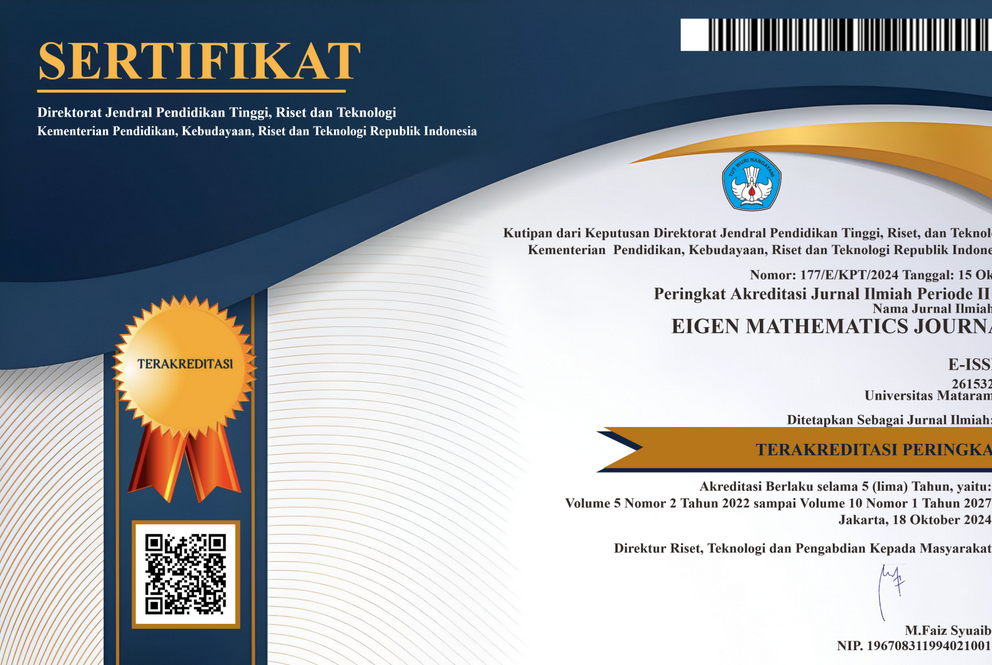Factor Analysis for Mapping Characteristics in Robusta Coffee Decaffeination Experiments
DOI:
https://doi.org/10.29303/emj.v5i1.139Abstract
In recent years, there has been a positive trend in coffee consumption in Indonesia. Coffee that was initially identical to older man's drinks is starting to be liked by teenagers and children because coffee contains caffeine which can have an addictive effect. Coffee has various benefits, such as preventing drowsiness, antioxidants, improving brain performance, and reducing fatigue. However, drinking a lot of coffee than your body can tolerate will cause symptoms of insomnia, excessive anxiety, and increased blood pressure. Various experiments have been made to reduce the caffeine content in coffee (decaffeination), one of which is mixing coffee with chayote juice (Sechium edule). Furthermore, this article classified the characteristics of decaffeinated products, caffeine content, moisture content, total acid titration, ash content, hue color, and L value. Using factor analysis, it is known that the characteristics can be mapped into three principal components. The first principal component consists of variables of caffeine content, water content, and hue color value. The second principal component consists of ash content and total acid content titration variables, and the third principal component, this factor, consists only of the characteristic L. It is also known that these three main components can explain 74.2% of the diversity of origin.References
Anuraga, G. (2015). Analisis Biplot untuk Pemetaan Karakteristik Kemiskinan pada Kabupaten/Kota Di Jawa Timur. J Statistika Vol. 7 juli 2015.
Gorsuch, R. L. (1983). Factor analysis (2nd ed). Hillsdale, NJ: Lawrence Erlbaum Associates.
Hair, J.F., et al.. (2010). Multivariate Data Analysis 7th Edition. America: Pearson Prentice Hall, 2010.
Hardle.W and Simar. L. (2003). Applied Multivariate Statistical Analysis. Springer, New York, 2003.
Kim, J. O., & Mueller, C. W. (1978). Introduction to Factor Analysis: What it is and how to do it. Beverly Hills, CA: Sage.
Mariana. (2013). Analisis Komponen Utama. Jurnal Matematika dan Pembelajaraannya 2013 Vol.2 No.2 . 99-114.
Martono, G.H., et al. (2012). Penggunaan Metodologi Analisa Komponen Utama (PCA) untuk Mereduksi Faktor-Faktor yang Mempengaruhi Penyakit Jantung Koroner. Seminar nasional “science, Engineering, and technology”
Paramartha, D.N.A., et al. (2022). Pengaruh Konsentrasi dan Lama Perendaman Dalam Sari Labu Siam (Sechium edule) Terhadap Dekafeinasi Kopi Robusta. Prosiding Saintek LPPM Universitas Mataram, Vol 4 Januari 2022. 93-105.
Purwanto, D. (2018). Analisis Faktor: Konsep, Prosedur Uji Dan Interpretasi. Jurnal Teknodik, 4(15),153–169.
R. A. Johnson and D. W. Winchern. (2007). Applied Multivariate Statistical Analysis. Pearson Education Inc., USA, 2007.
Ratnaningsih, D. (2015). Dekafeinasi Kopi Robusta (coffea canephora L.) dengan Ekstra Kasar Enzim Brpmelin dari Kulit Nanas (Ananas Comosus). Skripsi tidak diterbitkan. Malang : Universitas Brawijaya.
Ratnayani, K.,et al. (2015). Uji Aktivitas Protease Getah Labu Siam dan Talas Serta Perbandingannya Terhadap Getah Pepaya. J. Kimia. 9 (2) : 147-152.
Rohana, B.P.S., et al. (2018), “Analisis Biplot Menggunakan Singular Value Decomposition Pada Pengelompokkan Indeks Pembangunan Manusia Provinsi NTB”, Prosiding Seminar Nasional Pendidik dan Pengembang Pendidikan Indonesia
Sharma, S., (1996). Applied Multivariate Techniques. John Wiley & Sons, New York, 1996.
Tabachnick, B.G., & Fiddell, L. S. (2007). Using multivariate statistics (5th ed). Upper Saddle River, NJ: Pearson Allyn & Bacon.
Downloads
Published
How to Cite
Issue
Section
License

This work is licensed under a Creative Commons Attribution-NonCommercial-ShareAlike 4.0 International License.
All articles published in the Eigen Mathematics Journal will be available for free reading and downloading. The license applied to this journal is Creative Commons Attribution-Non-Commercial-Share Alike (CC BY-NC-SA).
Similar Articles
- Ena Setiawana, Nurul Fitriyani, Lisa Harsyiah, Modeling the Open Unemployment Rate in Indonesia Using Panel Data Regression Analysis , EIGEN MATHEMATICS JOURNAL: Vol. 7 No. 1 (2024): June
You may also start an advanced similarity search for this article.
Most read articles by the same author(s)
- Rifdah Fadhilah, Lisa Harsyiah, Nuzla Af’idatur Robbaniyyah, The Decision on Selecting the Best Laptop Using Analytical Hierarchy Process and Simple Additive Weighting Method at the Faculty of MIPA University of Mataram , EIGEN MATHEMATICS JOURNAL: Vol. 7 No. 2 (2024): December
- Lailatul Pahmi, Emmy Dyah Sulistiowati, Lisa Harsyiah, Analysis of Bottled Water Quality Control Using the FMEA Method and the Application of Kaizen (Case Study at PT. Lombok Pusaka Adam, Jelantik, Central Lombok) , EIGEN MATHEMATICS JOURNAL: Vol. 5 No. 1 Juni 2022
- Ena Setiawana, Nurul Fitriyani, Lisa Harsyiah, Modeling the Open Unemployment Rate in Indonesia Using Panel Data Regression Analysis , EIGEN MATHEMATICS JOURNAL: Vol. 7 No. 1 (2024): June
- Gangga Anuraga, Dito Anurogo, Fenny Fitriani, Hani Brilianti Rochmanto, Zulhan Widya Baskara, Integrative Bioinformatics and Statistical Approaches for Identifying Prognostic Biomarkers and Therapeutic Targets in Breast Cancer , EIGEN MATHEMATICS JOURNAL: Vol. 8 No. 1 (2025): June
- Sulpaiyah Sulpaiyah, Syamsul Bahri, Lisa Harsyiah, Forecasting Rice Price with Double Exponential Smoothing and Fuzzy Time Series Methods (Case Study: Price of Rice in Mataram City) , EIGEN MATHEMATICS JOURNAL: Vol. 5 No. 2 Desember 2022
- Lisa Harsyiah, Nurul Fitriyani, Salwa Salwa, Peramalan Jumlah Siswa Baru Madrasah Aliyah (MA) Manhalul Ma’arif Darek-Lombok Tengah , EIGEN MATHEMATICS JOURNAL: VOL. 3 NO. 2 DESEMBER 2020
- Vidya Atika Ramdani, Emmy Dyah Sulistyowati, Lisa Harsyiah, Comparative Analysis of the Graduates Quality of the Mathematics Study Program at the University of Mataram Using the Multivariate Exponentially Weighted Moving Average (MEWMA) Control Chart with T^2 Hotelling , EIGEN MATHEMATICS JOURNAL: Vol. 6 No. 1 Juni 2023
- Baiq Siti Patimah Zohrah, Syamsul Bahri, Zulhan Widya Baskara, Forecasting Non-Metal and Rock Mineral (MBLB) Tax Revenue Using the Fuzzy Time Series Markov Chain Method in East Lombok Regency , EIGEN MATHEMATICS JOURNAL: Vol. 7 No. 1 (2024): June
- Lisa Harsyiah, Zulhan Widya Baskara, Dina Eka Putri, Rifdah Fadhilah, Analysis of Factors that Influence Poverty in West Nusa Tenggara Using Principal Component Regression , EIGEN MATHEMATICS JOURNAL: Vol. 8 No. 1 (2025): June
- Muhammad Rizaldi, Nurul Fitriyani, Zulhan Widya Baskara, Modeling of Economic Growth Rate in West Nusa Tenggara Province with Longitudinal Kernel Nonparametric Regression , EIGEN MATHEMATICS JOURNAL: Vol. 7 No. 1 (2024): June






